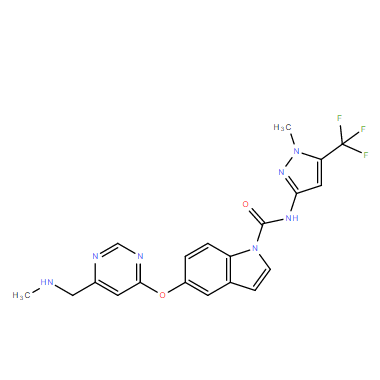| Cas No.: | 1229453-99-9 |
| Chemical Name: | Acrizanib |
| Synonyms: | Acrizanib;F2CB8801I3;Acrizanib [INN];XPIHPLVWOUDMPF-UHFFFAOYSA-N;N-(1-methyl-5-(trifluoromethyl)-1H-pyrazol-3-yl)-5-((6-((methylamino)methyl)pyrimidin-4-yl)oxy)-1H-indole-1-carboxamide;N-(1-methyl-5-(trifluoromethyl)-1H-pyrazol-3-yl)-5-(6-((methylamino)methyl)pyrimidin-4-yloxy)-1H-indole-1-carboxamide;1H-Indole-1-carboxamide, 5-((6-((methylamino)methyl)-4-pyrimidinyl)oxy)-N-(1-methyl-5-(trifluoromethyl)-1H-pyrazol-3-y |
| SMILES: | FC(C1=C([H])C(=NN1C([H])([H])[H])N([H])C(N1C([H])=C([H])C2C([H])=C(C([H])=C([H])C1=2)OC1C([H])=C(C([H])([H])N([H])C([H])([H])[H])N=C([H])N=1)=O)(F)F |
| Formula: | C20H18F3N7O2 |
| M.Wt: | 445.3978 |
| Purity: | >98% |
| Sotrage: | 2 years -20°C Powder, 2 weeks 4°C in DMSO, 6 months -80°C in DMSO |
| Description: | Acrizanib is a VEGFR-2 inhibitor, with an IC50 of 17.4 nM for BaF3-KDR. |
| Target: | VEGFR-2:17.4 nM (IC50) |
| In Vivo: | Rat ocular PK studies with Acrizanib shows a distinctly different profile from that observed with compound 25. While prolonged exposure is once again evident in the PEC, the AUC ratio to the level of Acrizanib in plasma is markedly increased (>21000-fold higher exposure in the PEC than plasma on day 11). Furthermore, unlike 25, Acrizanib also afford much improved retina to plasma AUC exposure ratio after 10 days of dosing (598× for Acrizanib vs 0.8× for 25)[1]. |
| In Vitro: | Acrizanib is a VEGFR-2 inhibitor, with an IC50 of 17.4 nM for BaF3-KDR. Acrizanib (compound 35) exhibits ≤10% remaining kinase activity against only 13 wild type kinases: CSF1R, Kit, PDGFRα, PDGFRβ, VEGFR1, VEGFR2, VEGFR3, Fms (soluble VEGFR1), DDR1, DDR2, TIE1, and ABL1 (nonphosphorylated)[1]. |
| References: | Rat ocular PK studies with Acrizanib shows a distinctly different profile from that observed with compound 25. While prolonged exposure is once again evident in the PEC, the AUC ratio to the level of Acrizanib in plasma is markedly increased (>21000-fold higher exposure in the PEC than plasma on day 11). Furthermore, unlike 25, Acrizanib also afford much improved retina to plasma AUC exposure ratio after 10 days of dosing (598× for Acrizanib vs 0.8× for 25)[1]. |

 DC Chemicals' products qualify for U.S. tariff exemptions. We guarantee no price increases due to customs duties and maintain stable supply, continuing to deliver reliable research solutions to our American clients.
DC Chemicals' products qualify for U.S. tariff exemptions. We guarantee no price increases due to customs duties and maintain stable supply, continuing to deliver reliable research solutions to our American clients.





















